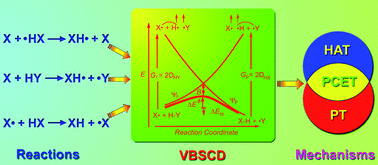Blended hydrogen atom abstraction and proton-coupled electron transfer mechanisms of closed-shell molecules†
Abstract
The paper addresses the surging topic of H-abstractions by closed-shell molecules, such as MnO4−,

* Corresponding authors
a
Institute of Chemistry and the Lise-Meitner-Minerva Center for Computational Quantum Chemistry, The Hebrew University of Jerusalem, 91904 Jerusalem, Israel
E-mail:
sason@yfaat.ch.huji.ac.il
Fax: +972-2-6584680
Tel: +972-2-6585909
The paper addresses the surging topic of H-abstractions by closed-shell molecules, such as MnO4−,

 Please wait while we load your content...
Something went wrong. Try again?
Please wait while we load your content...
Something went wrong. Try again?
C. Li, D. Danovich and S. Shaik, Chem. Sci., 2012, 3, 1903 DOI: 10.1039/C2SC20115A
To request permission to reproduce material from this article, please go to the Copyright Clearance Center request page.
If you are an author contributing to an RSC publication, you do not need to request permission provided correct acknowledgement is given.
If you are the author of this article, you do not need to request permission to reproduce figures and diagrams provided correct acknowledgement is given. If you want to reproduce the whole article in a third-party publication (excluding your thesis/dissertation for which permission is not required) please go to the Copyright Clearance Center request page.
Read more about how to correctly acknowledge RSC content.
 Fetching data from CrossRef.
Fetching data from CrossRef.
This may take some time to load.
Loading related content
